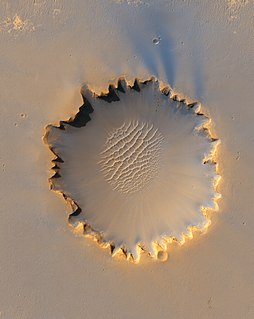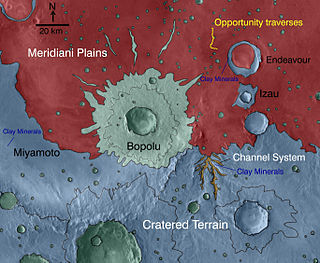
Meridiani Planum is a plain located 2 degrees south of Mars's equator, in the westernmost portion of Sinus Meridiani. It hosts a rare occurrence of gray crystalline hematite. On Earth, hematite is often formed in hot springs or in standing pools of water; therefore, many scientists believe that the hematite at Meridiani Planum may be indicative of ancient hot springs or that the environment contained liquid water. The hematite is part of a layered sedimentary rock formation about 200 to 800 meters thick. Other features of Meridiani Planum include volcanic basalt and impact craters.

Opportunity, also known as MER-B or MER-1, and nicknamed "Oppy," is a robotic rover that was active on Mars from 2004 until mid-2018. Opportunity was operational on Mars for 5110 sols. Launched on July 7, 2003, as part of NASA's Mars Exploration Rover program, it landed in Meridiani Planum on January 25, 2004, three weeks after its twin Spirit (MER-A) touched down on the other side of the planet. With a planned 90-sol duration of activity, Spirit functioned until it got stuck in 2009 and ceased communications in 2010, while Opportunity was able to stay operational for 5111 sols after landing, maintaining its power and key systems through continual recharging of its batteries using solar power, and hibernating during events such as dust storms to save power. This careful operation allowed Opportunity to operate for 57 times its designed lifespan, exceeding the initial plan by 14 years, 46 days. By June 10, 2018, when it last contacted NASA, the rover had traveled a distance of 45.16 kilometers.

Beer is a crater lying situated within the Margaritifer Sinus quadrangle (MC-19) region of the planet Mars, named in honor of the German astronomer, Wilhelm Beer. It is located at 14.4°S 351.8°E.

Sinus Meridiani is an albedo feature on Mars stretching east-west just south of the planet's equator. It was named by the French astronomer Camille Flammarion in the late 1870s.

Endurance is an impact crater lying situated within the Margaritifer Sinus quadrangle (MC-19) region of the planet Mars. This crater was visited by the Opportunity rover from May until December 2004. Mission scientists named the crater after the ship Endurance that sailed to the Antarctic through the Weddell Sea during the ill-fated 1914-1917 Imperial Trans-Antarctic Expedition, considered to be the last expedition of the Heroic Age of Antarctic Exploration organized by Ernest Shackleton.

Eagle is a 22-metre long impact crater located on the Meridiani Planum extraterrestrial plain, situated within the Margaritifer Sinus quadrangle (MC-19) portion of the planet Mars. The Opportunity rover came to rest inside Eagle crater when it landed in 2004. Scientists were delighted that the rover landed there, as the crater contains rocky outcroppings that helped prove that Meridiani was once an ocean floor.

Fram is an impact crater located within the Meridiani Planum extraterrestrial plain, situated within the Margaritifer Sinus quadrangle (MC-19) region of the planet Mars. It was visited by the rover Opportunity (MER-B) on Sol 84, April 24, 2004.

Heat Shield Rock is a basketball-sized iron-nickel meteorite found on the Meridiani Planum plain of Mars by the Mars rover Opportunity in January 2005.

Victoria is an impact crater on Mars located at 2.05°S, 5.50°W in the Meridiani Planum extraterrestrial plain, lying situated within the Margaritifer Sinus quadrangle (MC-19) region of the planet Mars. This crater was first visited by the Mars Exploration Rover Opportunity. It is roughly 800 metres (2,600 ft) wide, nearly eight times the size of the crater Endurance, visited by Opportunity from sols 951 to 1630. It is informally named after Victoria – one of the five Spanish ships of Ferdinand Magellan and the first ship to circumnavigate the globe – and formally named after Victoria, Seychelles. Along the edges of the crater are many outcrops within recessed alcoves and promontories, named for bays and capes that Magellan discovered.

Bounce Rock is a football-sized primarily pyroxene rock found within the Margaritifer Sinus quadrangle (MC-19) region of the planet Mars. It was discovered and observed by the Mars Exploration Rover Opportunity in April 2004. The rock was named for it having been struck by Opportunity as the craft bounced to a stop during its landing stage.

The Margaritifer Sinus quadrangle is one of a series of 30 quadrangle maps of Mars used by the United States Geological Survey (USGS) Astrogeology Research Program. The Margaritifer Sinus quadrangle is also referred to as MC-19. The Margaritifer Sinus quadrangle covers the area from 0° to 45° west longitude and 0° to 30° south latitude on Mars. Margaritifer Sinus quadrangle contains Margaritifer Terra and parts of Xanthe Terra, Noachis Terra, Arabia Terra, and Meridiani Planum.

Endeavour is an impact crater located in the Meridiani Planum extraterrestrial plain within the Margaritifer Sinus quadrangle (MC-19) region of the planet Mars. Endeavour is about 22 kilometers (14 mi) in diameter. Using Mars Reconnaissance Orbiter data, phyllosilicate-bearing outcrops have been detected along its rim. These minerals may have formed under wet conditions in a low-acidic environment during the early history of Mars. There are raised rim segments to the north, east, and southwest. The rim has become worn, rounded and degraded, with infilling of plains material in a manner similar to the Victoria crater.

Iazu is an impact crater located within the Meridiani Planum extraterrestrial plain, situated within the Margaritifer Sinus quadrangle (MC-19) region of the planet Mars. This geological feature is about 7 km in diameter. It is close to the landing site of the Mars Exploration Rover-B Opportunity, and its walls have been photographed by the spacecraft during its traverse to Endeavour Crater. At the time, the crater was about 38 kilometers (24 mi) away. It was named in 2006 for Iazu, a commune in Dâmboviţa County, southern Romania.
Mars may contain ores that would be very useful to potential colonists. The abundance of volcanic features together with widespread cratering are strong evidence for a variety of ores. While nothing may be found on Mars that would justify the high cost of transport to Earth, the more ores that future colonists can obtain from Mars, the easier it would be to build colonies there.
Santa Maria is an impact crater on Mars, located at 2.172°S, 5.445°W within the Meridiani Planum extraterrestrial plain, lying situated within the Margaritifer Sinus quadrangle (MC-19) region.

The composition of Mars covers the branch of the geology of Mars that describes the make-up of the planet Mars.

Opportunity is a robotic rover that was active on the planet Mars from 2004 to 2018. Launched on July 7, 2003, Opportunity landed on Mars' Meridiani Planum on January 25, 2004 at 05:05 Ground UTC, three weeks after its twin Spirit (MER-A), also part of NASA's Mars Exploration Rover Mission, touched down on the other side of the planet. While Spirit became immobile in 2009 and ceased communications in 2010, Opportunity exceeded its planned 90 sol duration of activity by 17 years, 201 days. Opportunity continued to move, gather scientific observations, and report back to Earth until 2018. What follows is a summary of events during its continuing mission.

Cape York is a location on Mars, on the western rim of Endeavour crater. The Opportunity rover spent about two years exploring this portion of the rim in the early 2010s before moving south. The CRISM instrument on the Mars Reconnaissance Orbiter identified clay smectites in an area of Cape York, and the rover was sent to explore this location. MER-B Opportunity spend its fifth Martian Winter at Greeley Haven at Cape York, and also took a panorama at that location. MER-B spent 19 weeks stationed at Greeley Haven surviving the winter and went on the move again in May 2012, to further explore Cape York.

Cape Tribulation is a section of the Western rim of Endeavour crater on the planet Mars. The MER-B Opportunity rover spent 30 months exploring Cape Tribulation from 2014 to 2017. The top of Cape Tribulation is about 134 meters higher than the plains that surround the crater.





















